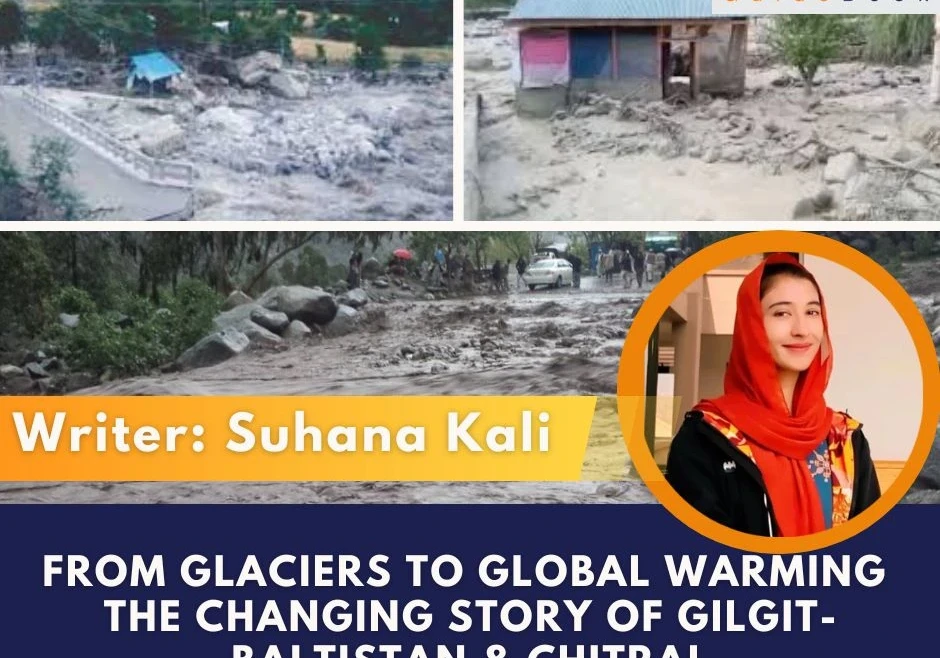Gilgit-Baltistan — a land of snow-covered mountains, azure lakes, winding rivers, and lush valleys — is a region blessed by nature with a beauty that only a few corners of the world are fortunate enough to possess. Here, the mountains stand in majestic glory, the glaciers stretch in unmatched vastness, and the coolness in the air brings joy to body and soul. Once, this region was not just a marvel of beauty but a lifeline — where water, air, and land worked together to sustain its settlements.
There was a time when the crystal-clear water flowing from the glaciers gave life to the fields. The canals carried water so pure and cold that no filtered water could compare. People would sit under the shade of trees, chatting, resting, and enjoying nature’s cool breeze. This water was the primary source for drinking, irrigating crops, and sustaining life. But today, those same canals and springs are no longer fit even for bathing or swimming.
Glaciers, once symbols of life, are now melting at an alarming rate, bringing with them a message of destruction. This was once a land where water played the music of streams, but today, the same water sweeps away entire settlements. Nature, in its silence, seems to be taking revenge, while we, prisoners of our own apathy, watch on like spectators.
The white cloak of snow that for centuries draped the mountain peaks of Gilgit-Baltistan and Chitral is now rapidly slipping away. There was a time when this snow would recede slightly in summer and return in winter, but now, with each passing year, the blanket grows thinner. The wind that once carried a refreshing chill now often brings waves of heat.
Between the snow-capped peaks, the same glaciers that once fed fields with fresh water are now melting at unprecedented speed, carrying with them a warning of catastrophe. Across the globe, greenhouse gas concentrations have crossed 410 parts per million — the highest level in the past 800,000 years. The year 2024 has been declared the hottest on record, and there is now an 86% chance that within the next five years, the global temperature will rise beyond 1.5°C.
Pakistan, one of the least responsible but most affected countries by climate change, has already seen 33 million people displaced, 1,739 lives lost, and $40 billion in damages during the floods of 2022. From Gilgit-Baltistan’s glaciers alone, 450 billion tons of ice melt each year — the source of 75% of our water supply — but in the future, this could turn into severe drought and water shortages. If this continues, the journey from ice to fire will no longer be just a tale in books but a bitter truth for our last generations.
We have blamed nature and declared ourselves innocent, while the reality is that the fault lies with us — and we are knowingly ignoring this truth. Global warming is not a sudden disaster; it is a silent destruction of our own making. For thousands of years, the Earth’s temperature remained within a balanced range, but after the industrial revolution, we recklessly burned coal, oil, and gas, cleared forests, and filled the atmosphere with gases that trap the sun’s heat on Earth.
Gilgit-Baltistan and Chitral are among the few regions in the world that host the largest non-polar glaciers. They provide 75% of Pakistan’s water, yet rising temperatures are causing them to melt at an extraordinary rate. This has led to “Glacial Lake Outburst Floods” (GLOF) — sudden floods that can wipe out bridges, roads, fields, and villages in the blink of an eye. In the past, the climate here was cool and moderate. Even in summer, the air carried a refreshing chill, the snow melted gradually, and the rivers ran strong. Today, the situation has changed — snow is disappearing faster, rainfall patterns have been disrupted, and we see alternating cycles of drought and unseasonal heavy rain.
Our own actions have worsened this crisis — uncontrolled construction, deforestation, illegal housing along riverbanks, excessive use of plastic and fossil fuels, and ignoring environmental laws. We believe this is someone else’s problem, but in truth, this disaster is standing at our own doorstep.
If we do not take serious steps today to protect the mountain ice, future generations will only see glaciers in pictures and fight over water. The solution does not lie in waiting for a miracle — it lies in small but consistent actions: planting trees, protecting water sources, reducing pollution, and respecting the balance of nature.
Remember, global warming is not just a scientific term — it is a question of life and death. The journey from ice to fire is one we have chosen ourselves, but if we wish, we can stop it here. The decision is ours — either we save the coolness of the mountains or leave behind a burning Earth for the generations to come.
Written by: Suhana Kali
Translated by: Tourism Guide Book


